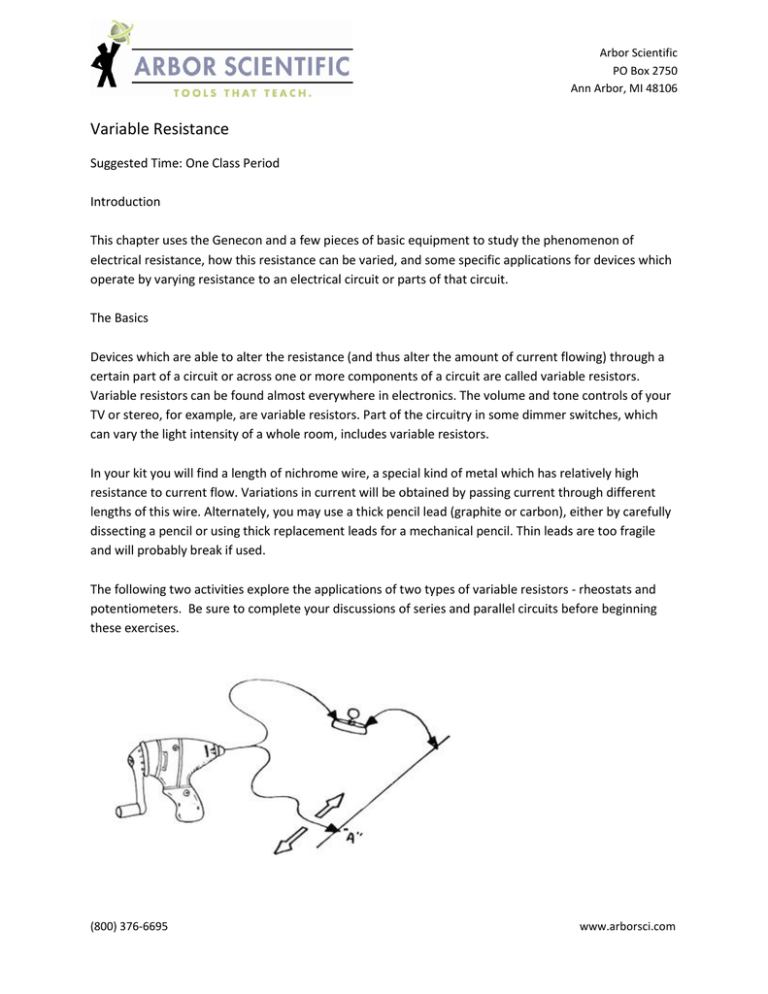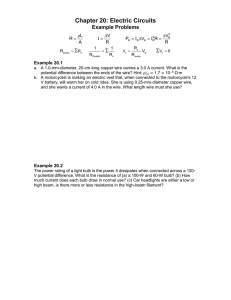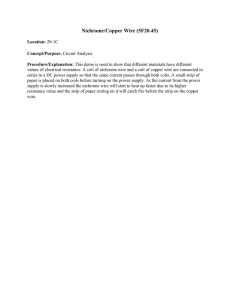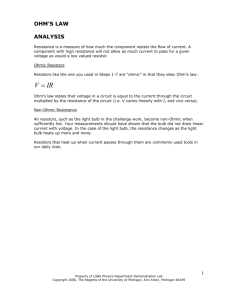Variable Resistance
advertisement

Arbor Scientific PO Box 2750 Ann Arbor, MI 48106 Variable Resistance Suggested Time: One Class Period Introduction This chapter uses the Genecon and a few pieces of basic equipment to study the phenomenon of electrical resistance, how this resistance can be varied, and some specific applications for devices which operate by varying resistance to an electrical circuit or parts of that circuit. The Basics Devices which are able to alter the resistance (and thus alter the amount of current flowing) through a certain part of a circuit or across one or more components of a circuit are called variable resistors. Variable resistors can be found almost everywhere in electronics. The volume and tone controls of your TV or stereo, for example, are variable resistors. Part of the circuitry in some dimmer switches, which can vary the light intensity of a whole room, includes variable resistors. In your kit you will find a length of nichrome wire, a special kind of metal which has relatively high resistance to current flow. Variations in current will be obtained by passing current through different lengths of this wire. Alternately, you may use a thick pencil lead (graphite or carbon), either by carefully dissecting a pencil or using thick replacement leads for a mechanical pencil. Thin leads are too fragile and will probably break if used. The following two activities explore the applications of two types of variable resistors - rheostats and potentiometers. Be sure to complete your discussions of series and parallel circuits before beginning these exercises. (800) 376-6695 www.arborsci.com Arbor Scientific PO Box 2750 Ann Arbor, MI 48106 Suggested Activities Rheostats A rheostat varies current flow by varying the resistance of an entire circuit. In a rheostat, the variable resistance is connected in series with the load. To set up a simple rheostat, arrange your Genecon, a bulb base, jumper wires, and length of nichrome wire as illustrated on page 12. Turn the handle of the Genecon at as constant a rate as possible (practice!) while your lab partner slides the connector labeled “A” up or down the nichrome wire. As you might expect, the resistance increases as the length of the nichrome wire used increases. What happens to the brightness of the bulb during these changes in wire length? Where is it easiest to turn the Genecon handle? Where is it the hardest? Potentiometers A potentiometer uses a variable resistor to change the voltage across a load, that is, the connection of the resistor is in parallel with the load. Arrange the components of your circuit as shown below. Note that the bulb, connected in series for the rheostat, is now connected in parallel. Again crank the Genecon as uniformly as possible while a partner slides the clip lead “A” up or down the nichrome wire or pencil lead. Where is the bulb brightest - with a short or long length of resistance? Where is it easiest to turn the handle? Hardest? What affects the voltage across the bulb? Can you determine at which wire position the energy being used by the bulb is greatest? (800) 376-6695 www.arborsci.com






